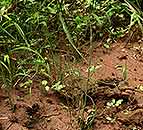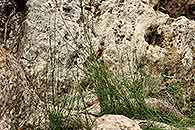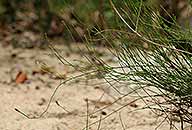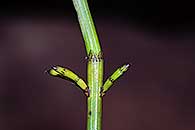Equisetum ramosissimum Desf. ssp. ramosissimum
Synonyms |
Equisetum thunbergii Wikstr. |
|---|---|
Common name |
|
Description |
Subterranean stem black, up to 6 mm in diameter, usually vertical and deeply buried, branching into horizontal stems, all rooting at the nodes and bearing aerial stems at intervals. Aerial stem hollow, up to 5 mm in diameter, longitudinally 10-20 ribbed, erect, c. 0.5-1 (2)m tall, with up to 16 thinner branches arranged in whorls at the nodes, up to 13 cm long, 1-1.5 mm in diameter. Leaves scale-like, up to 10 mm long, narrowly lanceolate with a single vein, often shiny-black with pale translucent margins, 1 per stemrib; 12-16 leaves unite for most of their length but with free black acuminate teeth up to 2 mm long and form a whorled sheath above each node. Strobili borne terminally on the main stem, oblong, 23 × 8 mm, with a blunt conical apex. |
Notes | |
Derivation | ramosissimum: much branched, referring to the numerous whorls of branches that this fern has at each node. |
Habitat | Moist areas, along perennial streams, in seasonally flooded areas and among grasses in full sun. |
Distribution worldwide | Africa, Madagascan region, Macaronesia, southern and central Europe, Asia (except Malaysia), south and central America. |
Distribution in Africa |
Algeria, Angola, Botswana, Burundi, Chad, Dem. Republic of Congo, Egypt, Ethiopia, Kenya, Lesotho, Liberia, Libya, Malawi, Mauritania, Morocco and Western Sahara, Mozambique, Namibia, Somalia, South Africa, Sudan and South Sudan, Swaziland, Tanzania , Tunesia, Uganda, Zambia, Zimbabwe. |
Growth form |
Lithophytic, terrestrial. |
Literature |
|





